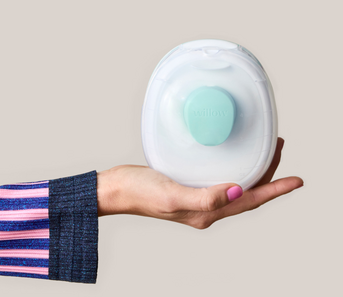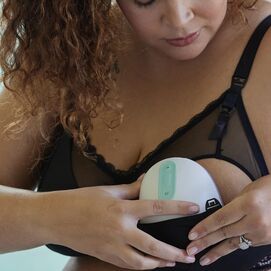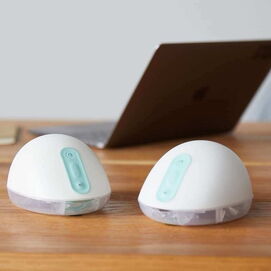Twins mean you’ve got double the love, mama. But does it mean double the work when it comes to breastfeeding? Although breastfeeding with twins can be challenging at first, you’ve got this. All you need are a few solid tips and tricks.
The Benefits of Breastfeeding With Twins
Some studies have shown that moms with multiples often choose to bottle feed their babies. These moms often feel anxious over the thought of feeding multiple babies at once. If this is you, we totally get it and support whatever you choose. A fed baby is a happy baby!
If you do choose to breastfeed your twins, there are many benefits for both you and your babies:
- Protection from sickness: Breastfed babies have fewer ear infections, allergies and respiratory issues. As you pass your antibodies to your babies, you help boost their little immune systems.
- Perfect nutrition for healthy growth: Your breast milk contains all of the necessary nutrients, protein and fat your baby needs to thrive and grow. And as your babies grow, your milk will change to fit their needs.
- Lower rates of cancer and illness for mom: According to the CDC, breastfeeding can reduce your risk of breast and ovarian cancer. Plus, it reduces the risk of high blood pressure and type 2 diabetes.
Establishing a Multiple Nursing Schedule
The first step for twin breastfeeding success is to establish a nursing schedule. Most babies will need to eat every 1-3 hours in the first few weeks, so you should plan on breastfeeding your babies 8-12 times each day.
With twins, one baby may be hungrier than the other or have different eating habits. That’s okay. Most moms will choose to feed both babies at the same time, whenever the hungrier baby signals it is time. Actually, feeding twins on-demand day and night is a great way to ensure your babies get enough to eat (plus, it delivers the best fat content for healthy growth).
Breastfeeding & Pumping With Twins
You can also decide that it’s best for you to exclusively pump and bottle feed your babies. If so, plan to pump at least every 2-3 hours to increase and maintain your supply. Each session should take around 15-20 minutes.
If you plan to pump and feed your babies from the breast, try to pump between each breastfeeding session. This ensures a solid pumping output and enough milk for your babies when it’s time to eat.
To simplify pumping, we recommend purchasing a breast pump that can express milk from both of your breasts at the same time. The Willow pump is wearable, so you can balance and juggle your sweet babes while you pump, hands-free.
Find your perfect pump.
Find your perfect pump.
Flexibility. Convenience. Control. No matter which pump you pick.
Tips for Breastfeeding With Twins & Multiples
One of the challenging parts of breastfeeding with twins is the logistics of it all. You now have two babies to juggle as you nurse. The good news is, there are plenty of ways to make breastfeeding easier on you and your sweet babes.
- Grab a Nursing Pillow
Nursing pillows eliminate the need for you to hold your babies in your arms as you breastfeed. There are specific pillows made for twins that allow your babies to rest on the pillow across your lap as you nurse. All you need to do is support their noggins. - Alternate Breasts
Each baby is different, even when it comes to being a twin. That means they’ll each have their own eating habits, likes and dislikes. One baby may eat a bit less or more than the other. Make sure both breasts are used equally by alternating breasts at each feeding. Complete one session and then switch the twins between breasts at the next. - Focus On the Latch
Whether you have twins or quintuplets, the latch when breastfeeding is the most important part. A good latch ensures your baby gets enough breast milk while reducing pain and discomfort for you. According to the Office on Women’s Health, if your baby has a good latch, you won’t see much of your areola (the darker skin around your nipple). Your baby’s mouth will also encompass your breast and his or her lips should turn outward, not inward. You should also see or hear your baby swallow.
FAQs On Breastfeeding With Twins
Should I Breastfeed My Babies at the Same Time?
It makes sense to breastfeed both of your babies at the same time. This helps you stick to your breastfeeding schedule and ensures both babies have full tummies. If you don’t feed your babies together, it can be hard to track which baby you’ve fed and which one you haven’t yet, especially in the first few weeks.
Will I Have Enough Milk?
Yes! Your body will know how much milk to make based on how much your babies eat and how often. Remember, it may take a few days after you have your babies for your milk to come in completely. And ebbs and flows in milk production can happen, especially if you’re not drinking enough water or having trouble emptying your breasts.
It’s important to take care of yourself too, mama. Drink plenty of liquids, try your best to get some sleep and eat a healthy diet. All of these things contribute to your breast milk supply.
How Do You Sleep With Hungry Newborn Twins?
The days and nights are long with a newborn baby. Add in a second baby and you may find yourself falling asleep standing up. As a twin mama, here are a few tips for ensuring you find time to rest:
- Take advantage of naps: We know you’ve heard the whole “sleep when the babies sleep” thing. And it’s true. Newborn babies sleep on and off throughout the day. Take advantage of these moments and catnap.
- Ask for help at night: Ask your significant other to help you out with nighttime feedings and diaper changes. Or, ask a relative or friend if they would be willing to stay with you a few nights a week to cuddle your babies.
- Consider bottle feeding: Supplementing with formula can be a great way to ensure your babies are fed and mama is (sort-of) rested. Or, you can add pumping into your routine and use expressed milk for nighttime feedings.
Can I Combine Breastfeeding & Formula Feeding?
Yes. If you have a naturally low supply of milk, want your significant other to help with the feeding or simply wish to combination feed, supplementing with formula is a great choice.
With multiples, pumping enough breast milk to keep a solid supply and breastfeeding may feel like you’re constantly expressing milk. Supplementing with formula can help you catch a break when you need it and even return to work if you choose.
Many experts recommend waiting at least a month before introducing formula into your routine, so you can build up your milk supply first. Then, try adding one or two bottles into your routine until you and your babies get the hang of it. If all goes well, you can decide how often you want to supplement.
Learn More About Breastfeeding With Willow
We know that breastfeeding or pumping can be a struggle at times. But, it’s more than worth it. Looking for tips on how to make the most of your breastfeeding experience? Want to learn more about breastfeeding and pumping? We can help! Check out our blog or go ahead and shop for your own wearable Willow pump.














